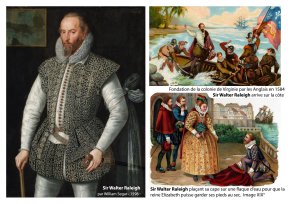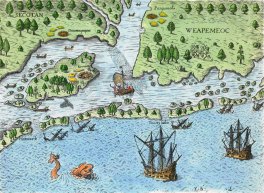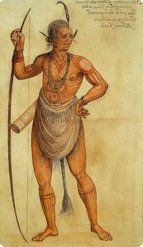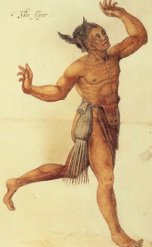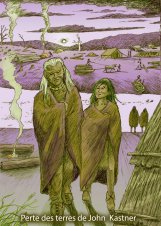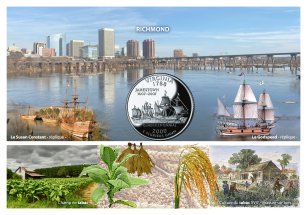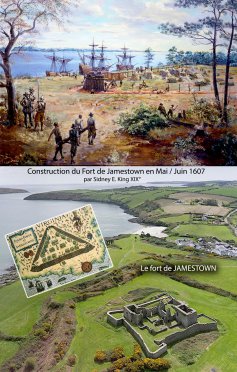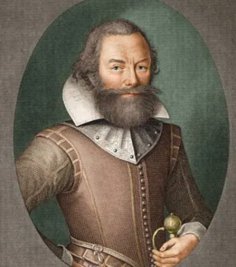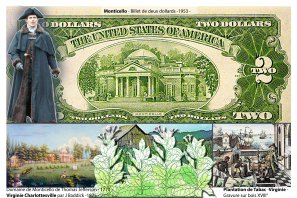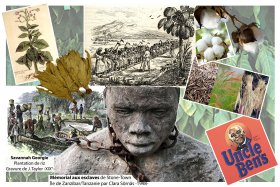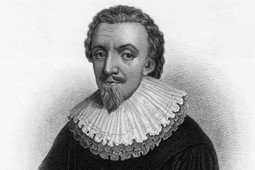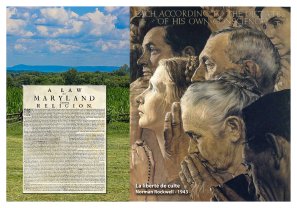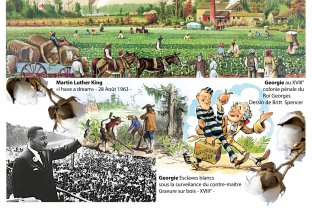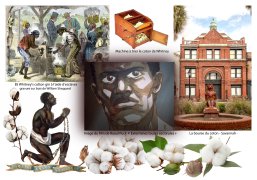Les colonies du Sud
Virginie, Maryland et Géorgie
Texte : Françoise Rochet
Illustration : Gratianne Garcia
Depuis le début de notre découverte de ces treize colonies anglaises d’Amérique, nous avons décidé de les visiter du Nord au Sud et de redescendre la côte Atlantique.
Nous voici enfin dans le Sud et nous commencerons par la Virginie.
C’est un État qui se trouve entre le Maryland et les Carolines.
Nous faisons donc une entrave dans notre itinéraire tout simplement parce que la Virginie est la première terre américaine conquise par les Anglais et c’est autour de cet État que vont s’articuler les autres colonies du Sud, Maryland, Caroline du Sud, Caroline du Nord et Georgie.
Le Sud est une terre agricole.
Le tabac, le riz et le coton seront une source de très grande richesse au détriment des esclaves.
Nous verrons que le roi accorde des concessions à ses favoris et à de grands seigneurs. Ceux-ci divisent une partie de leur propriété en lots et y établissent des fermiers qui paient un loyer symbolique.
De fermiers, ils deviennent insensiblement propriétaires.
A la veille de la Guerre d’Indépendance, l’Américain de l’époque coloniale mange plus que son contemporain européen. Il consomme de grandes quantités de lait, de fromage, de viande de porc et de boeuf (70 à 90 kilogrammes de viande par an). Le mouton sert à la fabrication artisanale de couvertures et de vêtements.
L’abondance est évidente : les fermiers donnent 60 % de leur production en grains aux animaux.
Cette agriculture prospère entraine un réseau commercial qui ne se limite pas qu’au tabac, au riz et à l’indigo.
Les colonies sont maintenant capables de vendre à l’étranger leurs surplus agricoles.
Outlander,
ses héros et leurs religions
Virginie
« À l’origine, la Virginie était toute l’Amérique. »
William Byrd II (1674-1744)
Marquées par un climat subtropical, les colonies du Sud avaient une économie tournée vers l'agriculture commerciale (tabac, coton, indigo, céréales, soie).
Les villes y étaient rares et relativement peu peuplées. (Charleston, Baltimore et Norfolk).
C’était un ensemble de grandes plantations aristocratiques où travaillaient des esclaves noirs.
La population d'origine africaine était plus nombreuse que dans les autres colonies.
Au XVIIIe siècle, elle fut le berceau de nombreux dirigeants militaires lors de la Guerre de Sept Ans puis lors de la Guerre d'indépendance ainsi que le point de départ des premières tentatives de s'étendre vers l'Ouest.
Si le mythe américain veut que l’acte fondateur de cette grande puissance soit l’arrivée du Mayflower en Nouvelle Angleterre, il n’en demeure pas moins que c’est en Virginie que commença l’aventure.
La Virginie est la première colonie anglaise d’Amérique du Nord. Durant tout le XVIIe siècle, elle est la plus peuplée des colonies anglaises continentales mais les débuts seront très chaotiques.
Avant de mettre les pieds sur le continent, les Anglais prirent possession d’une petite île.
Voici l’histoire de Roanoke.
Au début des années 1580, l’Angleterre et l’Espagne étaient au bord de la guerre.
La catholique Espagne considérait les Anglais comme d’infâmes hérétiques protestants, tandis que les Anglais jalousaient l’or, l’argent, les pierres précieuses que les Espagnols ramenaient fièrement d’Amérique sur leurs galions.
Les Anglais commençaient à comprendre l’importance d’une colonie pour contrer les Espagnols.
La reine Élisabeth 1ère chargea Sir Walter Raleigh de créer une colonie dans le Nouveau Monde.
Le défi était énorme :
Traverser l’Atlantique et affronter ses tempêtes ;
l’hostilité possible des Indiens d’Amérique ;
celle, bien réelle des Espagnols, déjà établis dans les Caraïbes et en Amérique du Sud.
En 1584, Walter Raleigh se chargea d’une expédition qu’il finança afin de repérer un site propice à l’établissement d’une colonie permanente en Amérique du Nord. Avec ses hommes, il trouva l’endroit idéal sur les côtes de l’actuelle Caroline du Nord, dans ce qu’on appelle aujourd’hui les Outer Banks.
Les Anglais choisissent cet endroit par prudence pour édifier leur première colonie, afin d’éviter de provoquer les Espagnols.
Walter Raleigh accoste le 27 avril 1584 et nomme la région Virginie en l'honneur de la reine d'Angleterre Elizabeth 1ère, (supposée vierge).
Cette première colonie s’installe donc sur l’île de Roanoke au dimension modeste de 30 kilomètres de long sur 10 kilomètres de large.
75 hommes, pour la plupart d’anciens soldats, furent débarqués sur l’île.
Hélas, ils se comportèrent comme des soudards vis-à-vis des Algonquins.
Ceux-ci s’étaient montrés accueillants ; les relations dégénèrent rapidement.
Après une année très difficile, sans ravitaillement, entourés d’Indiens désormais hostiles, les soldats-colons profitèrent du passage d’une flotte anglaise dans les parages pour se faire rapatrier.
Arrivant sur les lieux un mois plus tard, les navires de Raleigh trouvèrent la colonie abandonnée.
Ils laissèrent quinze hommes sur place puis reprirent la mer.
Lorsque le contingent suivant – 117 colons au total – arriva un an plus tard, les 15 hommes avaient disparu. Ils apprirent par les Croatan, une tribu indienne pacifique vivant sur une île voisine, que leurs colons avaient été attaqués par une tribu inconnue : 9 d’entre eux s’étaient enfuis à bord d’une barque, et nul ne les avait jamais revus.
C’est sous ces sombres auspices que « la colonie perdue de Roanoke » fut fondée officiellement, le 22 juillet 1587 avec 80 hommes, 17 femmes et 11 enfants 80 hommes, 17 femmes et 11 enfants.
Le 18 août 1587, une femme de la colonie, Eleanor Dare, donna naissance à une petite fille qu’elle prénomma Virginia ; c’était le premier enfant anglais né sur le sol américain.
Sans grandes ressources et apeurés, les colons envoyèrent en Angleterre leur gouverneur, John White (le grand-père de la petite Virginia), recruter de nouveaux soldats. Celui-ci partit sur l’unique navire dont disposait la colonie, laissant les colons de Roanoke sans aucun moyen de quitter l’île.
Mais le déclenchement de la guerre entre l’Angleterre et l’Espagne retarda de près de trois ans le retour du gouverneur.
Lorsqu’enfin il aborda à Roanoke le 18 août 1590, le jour du troisième anniversaire de sa petite-fille, il trouva la colonie complètement abandonnée.
Hélas, personne ne sut jamais ce que devint cette première petite américaine.
Qu’est-il arrivé aux colons de Roanoke ?
Les indices sont maigres, mais quelques suppositions ont été élaborées.
John White ne retrouva ni tombe ni reste humain dans la colonie.
Il paraît donc peu probable que ses habitants aient été massacrés par les Indiens : pourquoi auraient-ils emporté les corps puisque l’on sait que les Algonquins n’étaient pas cannibales ?
Autre possibilité, les Espagnols, en guerre contre l’Angleterre, auraient capturé les colons et les auraient réduits en esclavage. Mais les archives espagnoles montrent qu’ils ignoraient jusqu’à l’existence de la colonie de Roanoke.
John White retrouva deux inscriptions gravées sur des arbres de la colonie : CROATAN et CRO
Les colons auraient-ils été enlevés par les Croatans, ou bien se seraient-ils placés sous leur protection?
En 1587, ils étaient la seule tribu de la région qui conservait une attitude amicale envers les Anglais ; on peut donc espérer que le départ des colons fut volontaire et non forcé.
En 1590, ils étaient passés sur le continent. White et ses hommes ne purent entrer en contact avec eux.
Plus tard, des colons anglais ont noté que certains Algonquins de Caroline ressemblaient à des “Blancs”. Il n’y a cependant guère d’espoir que des études d’ADN permettent d’élucider la légende de la colonie perdue de Roanoke.
Les tribus algonquines de Caroline ont été anéanties en l’espace de quelques générations par les maladies et les armes apportées d’Europe par les vagues suivantes de colons. Des études climatologiques ont par ailleurs montré que la période 1587-1589 fut marquée par la pire sécheresse connue par l’Amérique en 800 ans.
Les colons de Roanoke, mourant de faim, se sont-ils remis à la miséricorde et la charité des Indiens ?
Roanoke devint dès lors la « Colonie perdue » pour toujours.
A la suite de ce drame, le territoire est inexploité pendant une vingtaine d'année.
Une expédition est financée par un groupe privé, la Compagnie de Virginie (ou de Plymouth) en vertu d'une Charte signée le 10 avril 1606 par le roi Jacques 1er dans le but d'établir une base permanente sur la côte nord-américaine car il fallait maintenir l'équilibre commercial entre l'Angleterre et l'Espagne. En fait, les Anglais prenaient enfin conscience de l’intérêt de posséder des colonies en Amérique.
Le 14 mai 1607, une poignée d'Anglais débarquent sur la côte nord-américaine et fonde un établissement permanent sur cette terre.
Dans un pays comme les États-Unis, si attaché aux fondations, cette flotte fondatrice a gagné la postérité. Les Américains fêteront la fondation de la Virginie, et par extension, celle des États-Unis en 2007, quatre cents ans plus tard avec comme slogan : « Le voyage qui changea le monde. »
Ce jour-là, trois navires, le Susan Constant, le Godspeed et le Discovery, accostent dans la baie Chesapeake, véritable mer intérieure au confluent de plusieurs estuaires.
À leur bord 105 hommes sous le commandement de sir Christopher Newport.
Ces migrants n’avaient qu’un but, améliorer leurs conditions économiques de vie.
Ils rêvaient de faire rapidement fortune.
C’étaient des fils cadets de familles nobles anglaises qui cherchaient or et pierres précieuses et qui espéraient trouver de grands domaines à exploiter.
Aucun n’était prêt à affronter la rude tâche qui les attendait.
Christopher Newport et ses hommes remontent la rivière qu’il baptise la « James River » sur 70 kilomètres et s’installent dans un site difficilement repérable par les Espagnols.
Ils se mettent immédiatement à la construction d’un fortin, Jamesfort, qui deviendra plus tard Jamestown
Les colons ont reçu des instructions précises de la Compagnie, déposées dans un coffre scellé qu’il leur est interdit d’ouvrir avant leur arrivée en Virginie.
Une fois sur place, ils découvrent qu’une administration va être mise en place.
Un président (Edward-Maria Wingfield) et des membres d’un conseil sont choisis.
Ils ont un ordre de mission :
* attaquer les Espagnols ;
* trouver des gisements d’or ;
* découvrir le fameux passage vers l’Asie ;
* entretenir de bonnes relations avec les Amérindiens et les évangéliser ;
* expérimenter toutes sortes de cultures afin de trouver des nouveaux produits d’exportation, comme le tabac dont le monopole était entre les mains des espagnols ;
* mettre les jalons d’une nouvelle politique ;
* fonder une colonie outre-Atlantique car les Anglais sont prêts à construire sur le long terme.
Tandis que le commandant rentre en Angleterre pour chercher du renfort, une poignée d'hommes demeurent sur place, dans le fort précaire de Jamestown.
Leur chef est un capitaine de 27 ans, John Smith. (1580-1631).
Les deux premières années sont terribles, notamment l’hiver 1609.
Elles seront appelées « starving time », « le temps de la faim » une expression systématiquement associée à l’histoire de la Virginie. Et cependant, le gibier et le poissons sont suffisants pour nourrir la petite colonie. Mais ces gentilshommes ne sont pas prêts à affronter cet environnement sauvage. Ils répugnent à défricher et à labourer la terre de leurs mains.
Les chaleurs écrasantes, les insectes et les eaux putrides des marécages amènent dysenterie et paludisme. De plus, ils subissent les attaques des Indiens.
Ils s'en sortent toutefois grâce à l'énergie de John Smith dont la détermination était grande.
Le capitaine John Smith est véritablement un personnage hors norme dont le destin a marqué les premières années de l’histoire de la Virginie et dont la vie aventureuse mérite d’être racontée.
Smith est un militaire de carrière qui a servi aux Provinces-Unies et en Écosse et a combattu contre les Turcs auprès du prince transylvanien Sigismond Ier Báthory.
Gravement blessé, il est fait prisonnier. Acheté comme esclave par un Turc qui souhaite l’offrir à sa maîtresse, il rejoint Istanbul à pied, enchaîné. Il se retrouve finalement sur les rives de la mer Noire.
Sitôt arrivé, Smith est immédiatement soumis à un traitement plus rude. Mis à nu, on lui rase le crâne et on lui met un collier en fer autour du cou. Il devient, selon ses propres termes, « l’esclave de tous les autres esclaves ». Un jour, cependant, alors que son maître le bat, Smith le tue, s’habille avec ses vêtements et s’enfuit. Il traverse l’Europe, rejoint l’Angleterre et s’embarque pour la Virginie.
Accusé de fomenter une mutinerie, c’est dans la geôle du Susan Constant que celui qui sera considéré comme le sauveur de Jamestown (et le prince charmant légendaire de Pocahontas) arrive sur les rives de la Chesapeake.
À partir de l’automne 1607, Smith prend les rênes d’une colonie assiégée par la faim et divisée par les dissensions.
Le capitaine John Smith a joué un rôle essentiel à un moment décisif dans l’histoire de Jamestown. Avec énergie, détermination, autorité, parfois même violence, il oblige tous les colons à semer du maïs pour se prémunir de la faim. Son credo, emprunté à saint Paul, est : « Celui qui ne travaille pas ne mangera pas non plus. »
L’objectif est de moins dépendre des autochtones pour se ravitailler. Smith fait aussi renforcer la palissade du fort et construire des habitations. Il mène également des expéditions le long des rivières et à l’intérieur des terres afin de cartographier la région et d’établir des contacts avec le plus grand nombre de villages amérindiens.
Mais il fallait trouver des sources de revenus dans cette colonie en devenir afin, non pas de survivre, mais de fructifier.
Les colons commencèrent rapidement à planter une herbe d'avenir, le tabac.
Ce fut le début de la prospérité.
John Rolfe (1585 -1622) est celui qui a introduit le tabac comme culture commerciale auprès des colons de Virginie. Sa production conditionna le futur développement de la colonie.
En mai 1610 John Rolfe et sa femme débarquèrent en Virginie ; son épouse mourut, probablement peu de temps après leur arrivée.
John Rolfe commença ses essais de plantation de tabac en 1612. Mais le tabac indigène de Virginie était trop fort pour le goût européen.
Sans que l'on sache comment, Rolfe obtint des graines d'une variété très en vogue cultivée à Trinité et en Amérique du Sud, alors que l'Espagne punissait de peine de mort quiconque vendait ce type de graines à qui n'était pas espagnol.
Rolfe planta des graines d'Indes Occidentales (Antilles) et produisit une récolte plus parfumée et douce que le tabac local, et qui, de plus, était bien adaptée aux conditions climatiques de la nouvelle colonie. Il découvre une méthode pour sécher le tabac et lui donner un goût qui a l’adhésion des Européens.
Vers 1617, les colons produisirent assez de tabac pour en livrer en Angleterre. Bien que le tabac de Virginie ait été considéré comme inférieur au tabac espagnol, il était abondant et bon marché.
Le rôle que joua John Rolfe dans l'introduction du tabac assura sa position dans la colonie puisqu’il avait trouvé le moyen économique de faire vivre de celle-ci.
En moins de 10 ans, la richesse était acquise en Virginie.
Il faut essayer d’imaginer la vie sur une plantation : voici celle de Georges Washington.
Le 30 juillet 1619 se tient dans l'église de Jamestown la première assemblée de la colonie.
Elle réunit, outre le gouverneur et ses six conseillers, 22 bourgeois qui représentent les colons. L'assemblée vote une première résolution concernant les impôts, la morale publique et le cours du tabac. C'est l'amorce de la démocratie représentative à l'américaine.
L'assemblée, se transformant en Parlement, affirme ses prérogatives face au gouverneur désigné par la Compagnie de Virginie, puis, à partir de 1624, par le roi d'Angleterre. Ses représentants seront beaucoup plus tard à la pointe du combat pour l'indépendance (Washington, Jefferson, Hamilton....).
En cette même année 1619, un bateau amène d'Angleterre 90 jeunes filles que les colons peuvent prendre pour femme sous réserve de payer leur voyage. Grâce à quoi la colonie va désormais croître et se développer sans plus dépendre de la métropole.
Mais il manquait de la main d’œuvre, d’autant plus que la culture du tabac était exigeante en terres qui s’épuisaient après 3 ans de culture. Il fallait donc régulièrement défricher, labourer, planter…
Certains actionnaires et investisseurs de la Virginia Compagny étaient des Puritains qui se sentaient responsables du peuplement de la nouvelle colonie. Ils veillèrent à n’engager que des travailleurs sous contrat présentant toutes les valeurs puritaines à savoir sobriété, travail et honnêteté. Toutes ces qualités permettaient d’obtenir un meilleur rendement et donc un meilleur retour sur investissement.
En août 1619, un bateau hollandais amène à Jamestown une cargaison d'un genre particulier : une vingtaine d'Africains. Les malheureux trouvent immédiatement preneurs auprès des planteurs, trop heureux de mettre la main sur une main-d'oeuvre plus docile et de santé moins fragile que les Indiens et les travailleurs blancs sous contrat.
Officiellement considérés comme des travailleurs ordinaires engagés sous contrat pour une durée de cinq ans, les Africains voient leur statut se dégrader.
Un esclavage, semblable à celui de l’Antiquité, va conduire à une malédiction dont les conséquences pèsent encore sur les États-Unis.
La colonie va désormais croître et se développer.
Toute plantation ressemble à un village. Elle est fixée presque toujours le long d’un cours d’eau pour faciliter les transports. La maison du maître est le bâtiment principal, parfois luxueux si le planteur est très riche. Autour, les dépendances : les cuisines, le fumoir, le lavoir, les ateliers des artisans, les étables et les écuries, non loin les cases des esclaves. La plantation est une exploitation agricole qui produit pour le commerce et comprend plusieurs fermes. Le planteur, lui, est un homme d’affaires, un commerçant et, dans le même temps, par son genre de vie un aristocrate, un gentleman farmer. Il parcourt son domaine aussi souvent que possible, tient soigneusement ses comptes et note les achats d’outils, de peintures, de fils, d’aiguilles, d’animaux, de semences. Rien ne lui échappe, s’il veut que son entreprise rapporte. George Washington, comme d’autres planteurs, se passionne également pour les expériences agronomiques. Il regrette que le monde des plantations dépende exagérément de l’Angleterre. Aussi décide-t-il d’élever des moutons pour ne point acheter de laine à Londres. Les vêtements seront moins chers et il suffira d’apprendre aux esclaves le tissage. Washington tire parti de la proximité du Potomac, le long duquel se trouve Mount Vernon, pour se livrer à la pisciculture. Élever et pêcher des poissons, encore une solution pour limiter les dépenses. Il se met à cultiver le blé qu’il transforme en farine. Il améliore aussi les méthodes de culture, pratique l’assolement qui repose la terre, utilise de nouveaux instruments agricoles, emploie des engrais. Bref, Washington cherche à pratiquer une agriculture moderne et acclimate, dans le potager de Mount Vernon, des plantes qu’il fera pousser plus tard dans ses champs. Il a même essayé de domestiquer des bisons. Mais il faut reconnaître qu’en Virginie, seul le tabac compte. Et dans ce cadre économique, le rôle du planteur et de ses délégués, les « surveillants », c’est d’organiser les activités, d’empêcher le gaspillage des énergies, de pousser au travail les esclaves. Sans les Noirs qui cultivent les champs ou, en petit nombre, servent le maître et sa famille, rien ne marche. Au sein de cette société qui se fonde sur la séparation des races, sur l’exploitation des Noirs par les Blancs, en un mot sur le racisme, les Blancs sont les patrons. Certes, Washington, comme beaucoup d’autres, n’aime pas le système esclavagiste. Mais à ses yeux, c’est un mal nécessaire dans une colonie qui manque de main-d’œuvre, où le climat subit des influences tropicales et dont les traditions sont celles d’un monde colonial.
Mais les colons estiment la Compagnie incapable de les protéger.
La Couronne nomme en 1623 une commission chargée d’enquêter sur les dysfonctionnements de cette dernière. Un an plus tard, la charte est annulée. La Compagnie, qui n’a jamais réussi à faire de bénéfices, est dissoute.
La Couronne prend le contrôle de la Virginie qui devient une colonie royale.
Avec cette reprise en main, la Couronne peut désormais contrôler le fructueux commerce du tabac.
Nous n’avons trouvé aucune cause religieuse qui amena ces hommes en Virginie.
Les Catholiques en furent bannis.
La plupart des migrants nobles et propriétaires des grands domaines étaient Anglicans.
Mais d’autres religions d’obédience chrétiennes s’y établirent.
L’Eglise presbytérienne, qui depuis sa naissance en Écosse s’était opposée aux Anglicans et à la couronne hanovrienne, s’installa par le biais des migrants Ecossais et Irlandais à partir de 1740.
Moins intellectuelle que l’église anglicane, elle rassemblait une société aux conditions plus modestes attirée par les psaumes et les chants. L’office correspondait mieux à cette population blanche et noire par sa simplicité biblique et les émotions qui en découlaient.
Mais cette église était quand même représentative de la société. Elle possédait des esclaves qu’elle louait à des petits planteurs qui cherchaient de la main d’œuvre.
Baptistes
Aidés par un grand mouvement spirituel, Premier Grand Réveil, dans les années 1760, les Baptistes attiraient les Virginiens, en particulier les pauvres fermiers blancs, dans une nouvelle religion beaucoup plus démocratique. Les esclaves étaient les bienvenus aux offices et beaucoup sont devenus baptistes à cette époque. Les services baptistes étaient très émouvants ; le seul rituel était le baptême, qui n'était appliqué que par immersion (pas par aspersion comme les Anglicans) qu'aux adultes. Les Baptistes appliquaient strictement leurs propres normes élevées de moralité personnelle, avec une préoccupation particulière pour l'inconduite sexuelle, la consommation excessive d'alcool, les dépenses frivoles, les services manquants, les jurons et les réjouissances dont faisaient preuves les coloniaux.
Méthodistes
Le Méthodisme est né au XVIIIe siècle en tant que mouvement au sein de l'église anglicane. Les missionnaires méthodistes étaient actifs à la fin de la période coloniale.
Les Méthodistes ont encouragé la fin de l'esclavage et ont accueilli les Noirs libres et les esclaves dans des rôles actifs dans les congrégations. Comme les Baptistes, ils ont fait des conversions parmi les esclaves et les noirs libres, et leur ont réservé plus d'accueil que dans l'Église anglicane. Certains noirs ont été choisis comme prédicateurs.
Après la Guerre d’Indépendance, des prédicateurs méthodistes itinérants portaient des copies d'une pétition anti-esclavagiste dans leurs sacoches dans tout l'État, appelant à la fin de l'esclavage. Ils encourageaient les propriétaires d'esclaves à affranchir leurs esclaves. Au cours des deux premières décennies après la guerre d'indépendance le taux était passé à 7,3 % de la population, contre moins de 1 %.
Avant de quitter cette colonie, penchons-nous sur la fameuse légende de Pocahontas.
Avant de quitter cette colonie, penchons-nous sur la fameuse légende de Pocahontas.
Le mythe est construit comme un récit positif de la colonisation.
Il symbolise aux yeux des Américains la fusion entre les Natifs et les Colons.
Son baptême et son mariage sont considérés comme d’autres actes fondateurs de la Nation.
C’est la raison pour laquelle la peinture du baptême orne le Capitole.
Une belle histoire, mais une histoire réécrite par John Smith pour accroître sa propre légende.
Son destin est pourtant beaucoup plus tragique.
Lorsque les colons arrivent, entre 25 000 et 30 000 Amérindiens, de la famille algonquine, rassemblés en quelque 200 villages, occupent le territoire « Tsenacommacah » ou « pays densément peuplé », tout autour de la baie de Chesapeake, (great water), qui est la transcription du son algonquin k’tchisipik.
Les Indiens les plus puissants et les plus fréquemment mentionnés dans les sources anglaises sont les Susquehannocks et, surtout, les Powhatans dont le chef est Wahunsenacawh.
Jusque-là, les Indiens avaient plus ou moins accepté la dépossession de leurs territoires par les nouveaux-venus. Mais jour après jour, les tensions montaient entre les deux communautés.
Que dit la légende ?
A cette époque, Jamestown est décimée par le froid, la famine et les épidémies.
Les Powhatans se montrent généreux et apportent de la nourriture aux colons. Les tensions grandissent ; Pocahontas est retenue comme otage dans l’espoir de libérer des colons et de négocier une paix avec les Indiens. Forcée de s’habiller comme une européenne, d’apprendre la langue, elle est aussi convertie au Christianisme et rebaptisée Rebecca. John Rolfe, le fameux planteur de tabac de la colonie tombe amoureux d’elle.
Le mariage sert en fait plusieurs intérêts.
* Pour le père de Pocahontas, chef de la tribu, il s’agit d’apaiser les tensions.
* Pour la compagnie de Virginie, l’apaisement est bon pour les échanges commerciaux.
* les Anglais le mariage montre le triomphe de la “civilisation” sur les autochtones.
En 1616, le couple quitte le continent pour venir se présenter à la cour d’Angleterre où elle est traitée comme “une princesse du Nouveau Monde ».
Mais Pocahontas ne s’accoutume pas à la vie londonienne et tombe malade.
Elle est enterrée sur les bords de la Tamise, bien loin de sa terre natale.
Beaucoup de grandes familles de Virginie vont se réclamer de Pocahontas, notamment l’ancienne première dame Nancy Reagan.
Maryland
« Notre bien-aimé et loyal sujet Cecilius Calvert, baron de Baltimore, dans notre royaume d’Irlande […], animé d’un zèle, pieux et louable, de répandre la religion chrétienne et étendre les territoires de notre empire, a humblement sollicité notre permission de transporter par ses propres efforts et dépenses une colonie nombreuse d’Anglais […] en Amérique. »
Charte du Maryland (1632)
Jusqu’aux années 1680, l’Angleterre n’a pas vraiment de politique coloniale.
La monarchie octroie des chartes et permet la création de compagnies mercantiles mais ne s’implique jamais car elle n’a que peu de projets. Elle accorde des privilèges et délègue les responsabilités et surtout elle laisse le coût de la colonisation à des courtisans et à des marchands.
Par conséquent, si l’Amérique sert de terre de refuge à des groupes religieux minoritaires, puritains, catholiques ou quakers, ce n’est pas le fruit d’une politique de tolérance.
Il s’agit de laisser-faire, voire d’indifférence et tout projet d’envoyer des dissidents outre-Atlantique résulte d’initiatives privées qui reçoivent juste l’aval de la Couronne.
Ainsi sont créées les colonies à propriétaires (proprietary colony).
Le mécanisme est simple.
La Couronne octroie une charte et un territoire à un groupe de courtisans (ou une famille) pour services rendus à la Couronne ou pour essuyer des dettes de la Couronne envers l’une ou l’autre famille noble. En échange de pouvoirs, les Seigneurs Propriétaires (Lords Proprietors) absorbent intégralement le coût de la colonisation.
Après avoir tenté une implantation à Terre Neuve, Sir George Calvert, premier Lord Baltimore décide d’acquérir des terres en Virginie, sous un climat plus clément. Il essuie un refus en raison de sa religion. L’accession au trône de Charles Ier, mieux disposé envers les Catholiques que son prédécesseur, il tente de nouveau sa chance. En 1632, l’année du décès de George Calvert, la charte est finalement octroyée à son fils Cecilius.
Ils gouvernent la colonie qui leur appartient comme ils l’entendent, même si les colons restent sujets du monarque, et s’occupent de peupler leur territoire
La Couronne étend son influence au-delà des mers sans rien dépenser.
Ce type d’arrangement est idéal pour un courtisan qui souhaite créer un espace de liberté pour ses coreligionnaires.
Le Maryland des Catholiques et la Pennsylvanie des Quakers sont de ce point de vue des cas d’école qui servent de modèle aux colonies à propriétaires.
La charte du Maryland crée une colonie à propriétaires qui appartient à une famille. Ceci est une nouveauté pour l’Amérique continentale anglaise, car les chartes de Virginie et du Massachusetts avaient été octroyées à des compagnies
Le territoire, situé au nord de la Virginie, le long du 40e degré de latitude nord, de la baie du Delaware jusqu’aux sources du fleuve Potomac, est baptisé très symboliquement et ostensiblement Maryland en l’honneur de la reine Henriette-Marie, la Catholique épouse de Charles Ier, et, plus discrètement, en celui de la Vierge Marie
Cecil Calvert second Lord Baltimore (1605-1675) était encore un jeune homme de 26 ans lorsque son père Sir George Calvert, mourut. Devenu le deuxième baron de Baltimore, il a également hérité des colonies et des terres appartenant à son père.
Le voici donc Lord Proprietor of Maryland alors qu’il s’était aussi converti au Catholicisme.
Cecilius Calvert est désormais un seigneur qui possède des pouvoirs législatifs, économiques et religieux étendus.
Il peut
· exploiter les éventuelles ressources minières ;
· fonder des villes et des paroisses ;
· lever des impôts ;
· légiférer, à condition que les lois soient en accord avec celles de l’Angleterre ;
· disposer des terres comme il l’entend ;
· et même créer une noblesse en distribuant des seigneuries assorties de privilèges justiciers.
En contrepartie de ces multiples pouvoirs, et dans un rapport de vassalité, il est stipulé que le propriétaire du Maryland remette au roi deux flèches d’Indien par an !
Le fait que cette charte soit octroyée à une famille catholique constitue une véritable originalité.
En Angleterre, peu de familles prestigieuses, proches de la cour, sont restées ou devenues catholiques. Elles représentent 1 % de la population et vivent en marge de la société.
L’octroi de la charte s’explique par l’influence personnelle de Sir Calvert et l’indifférence de la Couronne pour les affaires américaines dans ces années 1630.
Il invita les fils de familles (femmes, enfants et serviteurs catholiques) à naviguer vers le Maryland et à y établir la nouvelle colonie.
Il décida de rester en Angleterre car il voulait protéger sa colonie devant le souverain.
Il envoya son frère, Léonard et fit de lui le premier gouverneur de la colonie en mars 1633.
Cecil donna à son frère un ensemble d'instructions pour l'aider à gouverner la colonie. Ce document, appelé « Instructions aux colons par Lord Baltimore », est devenu la base des lois du Maryland.
Cecil voulait s'assurer que les Catholiques et les Protestants soient traités équitablement sous le nouveau système de gouvernement. Il a permis aux Catholiques de pratiquer leur religion.
Cecil n'a jamais pu visiter sa colonie en raison des problèmes sociaux et politiques en Angleterre.
Si l’intention était louable, elle fut vite rattrapée par les Test Act qui s’imposèrent sur le Royaume et ses colonies en 1673 et 1678.
Les Test Act étaient des lois pénales imposées aux Catholiques et aux non-conformistes (Quakers et Puritains et même Église presbytérienne d’Ecosse) afin d’avoir accès à certaines fonctions, prérogatives ou droits dans le Royaume, tels que la propriété, fonctions de notaire, avocats, enseignants, hauts grades militaires, administrations
Les étudiants ne pouvaient s’inscrire ni à Oxford ni à Cambridge…
Le principe sous-jacent était que des sanctions sévères étaient prononcées contre les récusants, qu'ils soient catholiques ou non conformistes.
Pour bien comprendre ces lois, il faut intégrer quelques subtilités doctrinales.
L’Eglise anglicane pratique l’eucharistie sous les deux espèces, pain et vin.
Jacques 1er avait imposé ce sacrement à tous les croyants.
Pour les Anglicans, ces éléments ne font que symboliser la présence du Christ.
Pour les Catholiques, ils SONT le Christ.
Donc l’interprétation entre les Catholiques et les Anglicans est différente.
Cette distinction est essentielle.
Que disaient ces lois ?
Charles II, après la Restauration de la Monarchie, dicta une loi selon laquelle la Communion était un préalable obligatoire pour occuper un emploi public.
La première imposition de ce test fut la Corporation Act 1661 exigeant qu'en plus de prêter le serment de suprématie, tous les membres des corporations devaient, dans l'année suivant leur élection, recevoir le sacrement du Dîner du Seigneur selon les rites de l'Église d’Angleterre.
De suite il en découla un autre acte d’allégeance en 1673 dont le titre est
"Un acte pour prévenir les dangers qui peuvent arriver des récusants papistes".
Le serment du Test Act de 1673 était :
Ce serment faisait des Catholiques des exclus de la société puisqu’ils étaient les seuls à croire en la transsubstantiation !
L'Église anglicane obligea tous les colons à payer un impôt ecclésiastique.
Les Catholiques quittèrent alors la colonie pour la Pennsylvanie voisine où les Quakers leur permettaient d'exercer leur religion.
Même si des heurts opposèrent les Catholiques et Protestants, le Maryland avait ouvert ses portes aux Catholiques. Cet état de tradition démocrate est un lieu de tolérance ; il est réputé pour avoir vu naître la liberté de religion aux États-Unis.
Dans les trois premières décennies de leur installation, les Marylandais vivaient dans des conditions difficiles au sein de petites fermes familiales et cultivaient plusieurs variétés de fruits, de légumes, de grains, et élevaient le bétail.
Mais c’est le tabac qui finalement a dominé l’économie de la province.
Comme son grand voisin, la Virginie, le Maryland ne se développa en tant que colonie de plantation qu’à partir des années 1660, avec la restauration de la dynastie Stuart et surtout au XVIIIe siècle. En 1755, près de 40 % de la population du Maryland était noire.
Les planteurs du Maryland firent aussi un usage intensif de travailleurs engagés libres et aussi de forçats condamnés aux travaux forcés.
Les terres du Maryland étaient particulièrement fertiles. Les fermiers furent de plus en plus tentés d'exporter leurs productions vers d'autres régions, mais ils devaient parcourir de grandes distances pour les acheminer jusqu'au port le plus proche. Un système fluvial étendu a facilité les échanges de produits entre les plantations intérieures avec la côte atlantique pour l’exportation.
Le port de Baltimore fut fondé en 1706.
L'activité portuaire se développa rapidement grâce au commerce du tabac.
Le commerce fut également stimulé par les importations de sucre, la ville présentant l'avantage d'être plus proche des Caraïbes que d'autres ports comme New York ou Boston.
Baltimore fut frappée par les tensions, des embargos, des restrictions imposées par les Anglais à l’aube de la révolution. Les Baltimoriens se rangèrent de ce fait en majorité du côté de l’armée continentale lors de la Guerre d'Indépendance. Ainsi la ville accueille le Second Congrès continental de décembre 1776 à février 1777.
Baltimore était donc le second plus important port dans le sud des États-Unis au XVIIIè siècle, après Charleston en Caroline du Sud.
C’était une porte d’entrée en Amérique du Nord pour de nombreux immigrants européens.
C’était la porte de sortie des denrées américaines vers l’Europe.
Baltimore abrita un vaste chantier naval qui vint enrichir la région.
La ville fut nommée en souvenir de George Calvert.
La Géorgie
« Je rêve qu’un jour, sur les collines rouges de Géorgie, les fils des anciens esclaves et les fils des anciens propriétaires d’esclaves pourront s’asseoir ensemble à la table de la fraternité.
Je rêve qu’un jour, même l’État du Mississippi, un état qui étouffe dans la fournaise de l’injustice, qui étouffe dans la fournaise de l’oppression, sera transformé en une oasis de liberté et de justice.
Je rêve que mes quatre jeunes enfants vivront un jour dans une Nation où ils ne seront pas jugés sur la couleur de leur peau, mais à la mesure de leur caractère.
Je rêve qu’un jour, même en Alabama, avec ses abominables racistes, avec son gouverneur à la bouche pleine des mots “ opposition ” et “ annulation ” des lois fédérales, que là, même en Alabama, un jour, les petits garçons noirs et les petites filles blanches pourront se donner la main, comme frères et sœurs.
Je fais aujourd’hui un rêve ! »
Martin Luther King
Martin Luther King
Une fois de plus, voici un état qui va se fonder sur un idéal à l’image du grand dessein des Puritains de créer la cité idéale, de l’expérience de William Penn avec les Quakers ou de Lord Calvert avec les Catholiques.
La Géorgie associe une idée géopolitique classique (une barrière défensive entre la Caroline du Sud et la Floride espagnole) à une idée philanthropique inédite, offrir une deuxième chance aux endettés.
La Géorgie, dernière des Treize Colonies, fut donc créée par un général, James Oglethorpe (1696-1785) entre les Carolines et la Floride espagnole. La création remonte à 1732 et met fin aux entreprises de colonisation britannique en Amérique du Nord.
L’Angleterre s’inquiétait alors des ambitions espagnoles.
Le général James Oglethorpe entre dans la carrière politique.
Le sort des prisonniers pour dettes le touche. Il décide de faire partir pour l’Amérique ces malheureux et leur offrir l’occasion de commencer une deuxième existence.
La charte lui est accordée en 1732 pour une région située entre la Savannah et l’Altamaha.
Cette localisation n’a pas de quoi surprendre, puisque depuis une bonne vingtaine d’années les rumeurs circulaient sur la nécessité de bâtir une nouvelle colonie pour lutter contre les Espagnols.
Il obtient une concession du roi George III en 1729 et baptise cette colonie Géorgie en l’honneur du souverain.
Devenu gouverneur, Oglethorpe débarque sur le site de Savannah en février 1733 après avoir eu le pouvoir d’y amener des repris de justice, des insolvables, des indigents, des réfugiés allemands et suisses ainsi que des Juifs fuyant l'Inquisition espagnole et portugaise.
Mais il exclut les Catholiques libres.
Il fonde Savannah et accueille 1 810 pauvres (la moitié sont des Anglais, l’autre moitié des Allemands, des Écossais, des Suisses), puis 1 021 immigrants parmi lesquels 92 Juifs.
L’impératif du peuplement était essentiel et le choix des migrants étaient stratégiques afin de trouver des combattants prêts à se battre contre les Espagnols et les Français. De ce point de vue, les Moraves et les Quakers étaient un handicap en raison de leur pacifisme dans une zone frontalière convoitée par les puissances voisines.
C’est pourquoi l’installation des Juifs est encouragée en raison de la haine que leur vouait l’Inquisition espagnole. Ils ne pouvaient donc être que des colons loyaux bien décidés à défendre leur territoire.
Sur place, pourtant, l’arrivée d’une quarantaine de Juifs à l’été 1733 provoqua des réactions violentes.
Finalement, la communauté juive fut acceptée grâce à l’un de ses membres, un médecin d’origine portugaise – et le seul médecin des environs – qui parvint à enrayer une épidémie.
Oglethorpe oblige chacun de ces migrants à exercer un travail manuel, interdit la possession d'esclaves (alors que la Virginie et les Carolines, au nord, n'en manquent pas), prohibe les alcools...
Autant de dispositions qui suscitent une levée de boucliers et seront plus ou moins abolies avant la fin de la Charte en 1752, lorsque la Géorgie devint colonie royale.
L’Église anglicane y fut établie officiellement six ans plus tard, mais avec une tolérance assez généreuse pour la large proportion de dissidents qui la peuplait. Sauf, une fois encore, pour les Catholiques.
La proximité de la prospère Caroline du Sud change les conceptions.
Cette voisine prospère grâce à des exploitations agricoles beaucoup plus étendues et à une main-d’œuvre servile. Les Georgiens se décident à les imiter.
En 1752, un an avant que la charte ne vienne à expiration, la philanthropie est passée de mode. L’esclavage et le rhum sont autorisés. La Georgie, devenue une colonie royale, ne se distingue plus guère des autres établissements anglais d’Amérique du Nord.
La création de cette colonie est basée sur la Transportation Act 1717 : un système réglementé afin d’emmener les criminels vers les colonies d'Amérique du Nord pour un service sous contrat.
* Pour tout propriétaire, il était possible d’engager des condamnés, après avoir donné un cautionnement pour le transport et assurer que la durée du service serait accomplie.
* La loi permettait également de conclure un contrat avec les 15-20 ans, qui étaient prêts à être transportés et à servir jusqu'à huit ans de service sous contrat.
* Après la révolte des Jacobites, les Écossais subirent ce même sort. Mais considérés comme de valeureux guerriers, grands nombres furent incorporés dans l’armée de l’Empire britannique.
* Au cours des six décennies d'utilisation de la loi de 1717 dans ses colonies américaines, ce transport a contribué à fournir la main-d'œuvre coloniale dont on avait tant besoin, ce qui a augmenté sa production et a profité au royaume dans son ensemble.
En 1787, le transport britannique des criminels reprit avec le départ de la première flotte vers des colonies établies en Australie; son utilisation sera considérablement réduite dans les années 1850, mais se poursuivra jusqu'à l'arrivée du dernier en 1868
Oglethorpe construisit Savannah selon des plans uniques pour l’époque.
C’est le fameux plan Oglethorpe.
Au lieu de bâtir une ville circulaire, constituée comme une place forte, il lui donne un aspect rectiligne.
Oglethorpe en a dessiné les plans, tracés au cordeau à partir des bords de la rivière ; aux intersessions, il place des squares, pensés pour être des lieux d’entrainements pour les milices.
La ville était divisée en six quartiers et chaque maison s’accompagnait d’une parcelle cultivable.
En Géorgie, une autre ville a retenu notre attention… Darien.
Le nom de cette ville fut choisi en souvenir d’une autre colonie écossaise dont nous aurons l’occasion de parler plus tard. Le projet Darién est probablement la plus connue des tentatives coloniales écossaise, mais aussi la plus désastreuse. Dans les années 1690, en concurrence avec les autres puissances européennes, l’Écosse se lance dans le projet colonial de grande envergure à Darien, au Panama. L’échec de cette entreprise a conduit en partie à l’Union de l’Angleterre et de l’Écosse en 1707.
New Inverness ou Darien fut fondée en janvier 1736 par 177 Écossais Catholiques des Highlands (hommes, femmes et enfants) qui fuyaient le conflit entre Jacobites et Hanovriens.
Ces vaillants guerriers écossais, recrutés en tant que colons-soldats par Oglethorpe étaient principalement originaires des environs d'Inverness et se composaient de clans de soutien jacobites dont la majorité ne parlait que le gaélique.
Ils avaient un triple rôle :
· établir une nouvelle colonie ;
· servir de tampon, protéger la Géorgie des Espagnols, des Français et de leurs alliés Indiens ;
établir rapidement des forts militaires.
Lors de la visite d'Oglethorpe en février, les colons avaient déjà construit «une batterie de quatre pièces de canons, construit un poste de garde, un entrepôt, une chapelle et plusieurs huttes individuelles».
Darien a été également aménagé conformément au désormais célèbre plan Oglethorpe.
Ils firent de l'élevage, de l’agriculture et l'abattage des arbres pour survivre.
En 1739, 18 membres de la colonie furent signataires de la première pétition contre l'introduction de l'esclavage en Géorgie en réponse aux habitants de Savannah qui demandaient la levée de l'interdiction de l'esclavage.
La pétition des Highlanders eut quelque succès pendant un certain temps ; l'esclavage ne fut introduit que dix ans plus tard, en 1749 lorsque la colonie se transforma en grandes plantations à l’image de la Virginie.
Le tabac, le riz et le coton firent la fortune de la colonie.
Dès la fin des années 1790, les plantations de coton, inexistantes jusque-là, explosent, grâce à la machine à trier inventée par Eli Whitney en 1793 sur la plantation de Savannah River.
En 1790, l’Etat compte 29 264 esclaves pour atteindre 105 218 en 1810.
Au moment de la guerre de Sécession, on estime qu’ils étaient 500 000.
La Géorgie devient l'une des treize colonies à se révolter contre les Britanniques durant la guerre d'indépendance américaine.
Elle devient le quatrième État de l'Union le 2 janvier 1788.
T8-2 Ch126 « LE PLAN OGLETHORPE » décrit par Diana Gabaldon
Fin novembre
« Contrairement à la plupart des villes américaines, Savannah avait été soigneusement planifiée par son fondateur, un certain Oglethorpe. Je le savais parce que Mme Landrum, la dame à qui nous louions nos chambres, m’avait expliqué qu’elle était construite selon le «plan Oglethorpe». Elle avait prononcé le mot sur un ton pontifiant, car elle était apparentée au monsieur en question et intensément fière de la perfection de sa ville. Le plan était divisé en six quartiers, chacun étant composé de quatre îlots «civiques», pour les bâtiments administratifs, publics et commerciaux, ainsi que de quatre îlots en tything10réservés aux habitations, ces dernières étant disposées autour d’un square ouvert. Chaque îlot comptait dix maisons et les hommes de chaque tything effectuaient ensemble leur entraînement de miliciens. »….
…. « De mon point de vue, l’aspect le plus intéressant du plan de M. Oglethorpe (au cours de la conversation, je compris qu’il avait fondé non seulement Savannah mais également toute la province de la Géorgie) était que chaque maison s’accompagnait d’une parcelle cultivable longue de 1 600 mètres en dehors de la ville, ainsi que d’un potager de cinq arpents plus proches. Mes doigts me démangèrent aussitôt à l’idée de tripoter de la terre. — Vraiment? dis-je. Et… euh… que cultivez-vous? L’aboutissement de cette conversation (et de nombreuses autres du même genre) fut que j’obtins d’aider notre logeuse avec l’entretien de son potager en échange d’une part de sa récolte de «sassas» (pour une raison obscure, c’était ainsi qu’elle appelait certains légumes comme le chou frisé et le navet), de haricots et de maïs, ainsi que d’un carré où je pouvais faire pousser mes herbes médicinales. Autre conséquence de cette aimable accointance, Ian et Rachel, qui occupaient la chambre sous la nôtre, commencèrent à appeler leur futur bébé Oglethorpe, qu’ils abrégeaient courtoisement en «Oggy» lorsque Mme Landrum était dans les parages. »….
Bibliographie
· Bacharan, Nicole, Les Noirs américains. Des champs de coton à la Maison-Blanche, Paris, Perrin, coll. « Tempus », 2010.
· Henneton, Lauric, Histoire religieuse des États-Unis, Paris, Flammarion, 2012.
· Kaspi, André, Les Américains (1986), vol. 1 : Naissance et essor des États-Unis, 1607-1945 ; vol. 2 : Les États-Unis de 1945 à nos jours, Paris, Seuil, 5e éd. mise à jour, 2014.
· Kaspi, André, Durpaire François, Harter Hélène et Lherm Adrien, La Civilisation américaine (2004), Paris, Presses universitaires de France, 2006.
· Kempf, Jean, Une histoire culturelle des États-Unis, Paris, Armand Colin, 2015.
· Lacour-Gayet, Robert, Histoire des États-Unis, vol. 1 : Des origines à la fin de la guerre civile ;Paris, Fayard, 1976-1982.
· Lacorne, Denis (dir.), Les États-Unis, Paris, Fayard, 2006.
· Van Ruymbeke, Bertrand, "L'Amérique avant les États-Unis. Une histoire de l'Amérique anglaise, 1497-1776", Flammarion, Paris, 2016
· Zinn Howard, Cotton Frédéric, Une histoire populaire des États-Unis de 1492 à nos jours, Agone; 1er édition (13 septembre 2002)
Tabac et économie coloniale américaine (en anglais)




